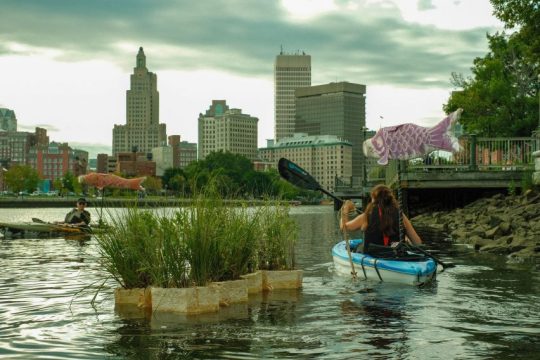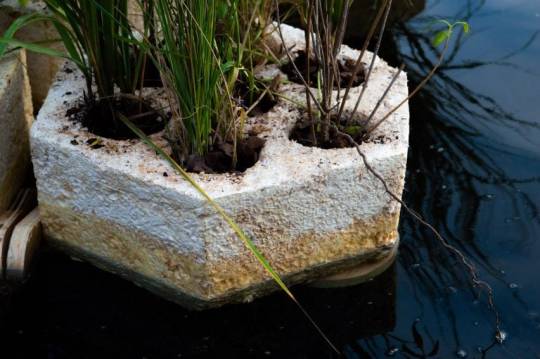Text
Im afrikanischen Meningitis-Gürtel sind die Meningokokken besonders gefährlich und verursachen tödliche Hirnhautentzündungen. Eine erste Impfkampagne gegen deren Serotyp A war erfolgreich, seit 2010 traten kaum noch Erkrankungen auf. Nun gibt es einen Kombinationsimpfstoff, der auch vor den Serogruppen C, W, Y and X schützt.
1 note
·
View note
Text
A Brief History of the Future ist eine einzigartige sechsteilige Dokumentarserie über unsere Zukunft und darüber, wie wir sie uns neu vorstellen können. Der renommierte Futurist Ari Wallach lädt die Zuschauer auf eine Reise um die Welt ein, die voller Entdeckungen, Hoffnungen und Möglichkeiten ist, wo wir uns heute befinden und was als nächstes kommen könnte.
1 note
·
View note
Text
In einem Ort in China haben die Einwohner ihre Häuser aus Austerschalen gebaut, weil Austerschalen damals ein Abfallprodukt waren. Moderne Forschung zeigt, dass die Austerschalen ein guter Wärmeisolator sind.
0 notes
Text
As relentless rains pounded LA, the city’s “sponge” infrastructure helped gather 8.6 billion gallons of water—enough to sustain over 100,000 households for a year.
Earlier this month, the future fell on Los Angeles. A long band of moisture in the sky, known as an atmospheric river, dumped 9 inches of rain on the city over three days—over half of what the city typically gets in a year. It’s the kind of extreme rainfall that’ll get ever more extreme as the planet warms.
The city’s water managers, though, were ready and waiting. Like other urban areas around the world, in recent years LA has been transforming into a “sponge city,” replacing impermeable surfaces, like concrete, with permeable ones, like dirt and plants. It has also built out “spreading grounds,” where water accumulates and soaks into the earth.
With traditional dams and all that newfangled spongy infrastructure, between February 4 and 7 the metropolis captured 8.6 billion gallons of stormwater, enough to provide water to 106,000 households for a year. For the rainy season in total, LA has accumulated 14.7 billion gallons.
Long reliant on snowmelt and river water piped in from afar, LA is on a quest to produce as much water as it can locally. “There's going to be a lot more rain and a lot less snow, which is going to alter the way we capture snowmelt and the aqueduct water,” says Art Castro, manager of watershed management at the Los Angeles Department of Water and Power. “Dams and spreading grounds are the workhorses of local stormwater capture for either flood protection or water supply.”
Centuries of urban-planning dogma dictates using gutters, sewers, and other infrastructure to funnel rainwater out of a metropolis as quickly as possible to prevent flooding. Given the increasingly catastrophic urban flooding seen around the world, though, that clearly isn’t working anymore, so now planners are finding clever ways to capture stormwater, treating it as an asset instead of a liability. “The problem of urban hydrology is caused by a thousand small cuts,” says Michael Kiparsky, director of the Wheeler Water Institute at UC Berkeley. “No one driveway or roof in and of itself causes massive alteration of the hydrologic cycle. But combine millions of them in one area and it does. Maybe we can solve that problem with a thousand Band-Aids.”
Or in this case, sponges. The trick to making a city more absorbent is to add more gardens and other green spaces that allow water to percolate into underlying aquifers—porous subterranean materials that can hold water—which a city can then draw from in times of need. Engineers are also greening up medians and roadside areas to soak up the water that’d normally rush off streets, into sewers, and eventually out to sea...
To exploit all that free water falling from the sky, the LADWP has carved out big patches of brown in the concrete jungle. Stormwater is piped into these spreading grounds and accumulates in dirt basins. That allows it to slowly soak into the underlying aquifer, which acts as a sort of natural underground tank that can hold 28 billion gallons of water.
During a storm, the city is also gathering water in dams, some of which it diverts into the spreading grounds. “After the storm comes by, and it's a bright sunny day, you’ll still see water being released into a channel and diverted into the spreading grounds,” says Castro. That way, water moves from a reservoir where it’s exposed to sunlight and evaporation, into an aquifer where it’s banked safely underground.
On a smaller scale, LADWP has been experimenting with turning parks into mini spreading grounds, diverting stormwater there to soak into subterranean cisterns or chambers. It’s also deploying green spaces along roadways, which have the additional benefit of mitigating flooding in a neighborhood: The less concrete and the more dirt and plants, the more the built environment can soak up stormwater like the actual environment naturally does.
As an added benefit, deploying more of these green spaces, along with urban gardens, improves the mental health of residents. Plants here also “sweat,” cooling the area and beating back the urban heat island effect—the tendency for concrete to absorb solar energy and slowly release it at night. By reducing summer temperatures, you improve the physical health of residents. “The more trees, the more shade, the less heat island effect,” says Castro. “Sometimes when it’s 90 degrees in the middle of summer, it could get up to 110 underneath a bus stop.”
LA’s far from alone in going spongy. Pittsburgh is also deploying more rain gardens, and where they absolutely must have a hard surface—sidewalks, parking lots, etc.—they’re using special concrete bricks that allow water to seep through. And a growing number of municipalities are scrutinizing properties and charging owners fees if they have excessive impermeable surfaces like pavement, thus incentivizing the switch to permeable surfaces like plots of native plants or urban gardens for producing more food locally.
So the old way of stormwater management isn’t just increasingly dangerous and ineffective as the planet warms and storms get more intense—it stands in the way of a more beautiful, less sweltering, more sustainable urban landscape. LA, of all places, is showing the world there’s a better way.
-via Wired, February 19, 2024
13K notes
·
View notes
Text
Berichterstattung hat eine Schlagseite, meist spricht sie nur von reaktionären Männerbildern. Inzwischen gibt es aber eine große Gemeinschaft von Männern, die ein neues und gleichberechtigteres Männerbild propagieren.
1 note
·
View note
Text
lebstoffe beruhen fast immer auf fossilen Rohstoffen wie Erdöl. Fraunhofer-Forschende haben nun ein Verfahren entwickelt, mit dem der biobasierte Rohstoff Keratin erschlossen wird. Die leistungsfähige Protein-Verbindung ist beispielsweise in Hühnerfedern enthalten. Damit kann man nicht nur eine Vielzahl unterschiedlicher Klebstoffe für verschiedene Anwendungsbereiche herstellen. Die Verfahren und Endprodukte sind vielmehr nachhaltig und orientieren sich am Grundprinzip einer bioinspirierten Kreislaufwirtschaft.
0 notes
Text
ETH-Forschende gewinnen das Edelmetall aus Elektroschrott. Ihre neue Methode ist besonders nachhaltig: Sie basiert auf einem Proteinfaserschwamm, den die Wissenschaftler aus Molke herstellen, einem Nebenprodukt der Lebensmittelindustrie.
1 note
·
View note
Text
In Zürich wischen Freiwillige Müll zusammen. Sie helfen so der Stadtreinigung im Kampf gegen Littering.
1 note
·
View note
Text
A team of Rhode Island School of Design students and researchers have created tesselated, floating planting beds made of a mycelium biomaterial to cleanse waterways of pollutants and restore wetland habitat.

The floating Biopods act to introduce native plants back to degraded wetland systems while cleansing the water through bioremediation, or the re-introduction of microorganisms that naturally decontaminate their environment.


"Because of the urbanization of the Providence River itself, a lot of the wetland that acts to actively remediate pollution had been removed. So the project is really about reintroducing this new biology to kick start these ecosystems again so that the river might repair itself."

"It's interesting, the relationships that we have to biomaterials and the way that we are connected to systems that have the potential to remediate in a way that isn't electricity intensive or chemically intensive," said Banerjee.
4K notes
·
View notes
Text
Der Lebensmittelmarkt Central de Abasto de la Ciudad de México versorgt mehrere Millionen Menschen mit Lebensmitteln. Lange wanderten unverkäufliche Lebensmittel auf die Müllkippe, diese Menge konnte inzwischen um knapp ein Viertel gesenkt werden.
0 notes
Text
2 notes
·
View notes
Text
Der Verein «Mein Baum dein Baum» pflanzt kostenlos Bäume für Hausbesitzer und will so das Stadtklima verbessern.
0 notes
Text
Der pflanzliche Parasit Striga hermonthica, auch Hexenkraut genannt, ist für die Landwirtschaft in Kenia ein gravierendes Problem. Denn Striga befällt vor allem Maispflanzen – ein wichtiges Grundnahrungsmittel der Region. Das biologische Bekämpfungsmittel „Kichawi Kill Sporenpulver“ soll Abhilfe schaffen und basiert auf einem einheimischen Schimmelpilz.
1 note
·
View note
Text
Zehntausende Schüler brechen jedes Jahr die Schule ab. In Mannheim geht Victoria nun wieder gern zum Unterricht. Neben Textanalyse gibt’s da nämlich Deep Talk.
3 notes
·
View notes
Text
Der peruanische Sänger Lenin Tamayo verbindet K-Pop mit Quechua, um die Andenkultur zu feiern.
1 note
·
View note
Text
Zu Ende gedacht – vierte Bedingung – bedeutet all das, dass es nicht reichen wird, wenn Israelis und Palästinenser ein Abkommen unterzeichnen. Es reicht nicht, einzelne Fäden über Jahrzehnte aus dem Knäuel zu lösen; es muss mit einem Schlag getrennt werden. Der Iran, Saudi-Arabien, die libanesische Miliz Hisbollah, die jemenitischen Huthis und andere für den Konflikt wichtige arabische Staaten wie Jordanien und Ägypten müssten mit am Tisch sitzen. Es brauche nun einen „grand bargain“, einen großen regionalen Kompromiss.
3 notes
·
View notes